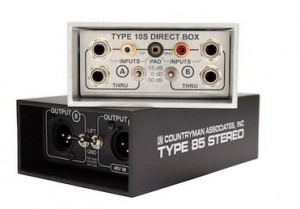Product Review: Countryman Type 10S and Type 85S DI Boxes
DI box, direct box, direct input or just DI… Just a few of the names we associate with that little piece of gear that allows us to plug our guitars, keyboards and other 1/4 inch touting instruments into our XLR inputs at the mixer. This of course is a very simple concept since a 1/4″ connector does not fit into an XLR jack. So, of course, we need a magical box to make it work for us. 
Have you ever thought about what actually happens when a signal is passed through a DI? What makes this DI better over that one? There is a little more to it than you may think.
Ultimately we are taking a high impedance input and converting it to a balanced XLR output to connect to our mixer. That’s the basic function, but where DI’s excel (or not) is in how accurately they pass these signals through to the console. The last thing you want is to pass your instrument through another box that will alter the sound just a little more. Countryman has been working for a long time to deliver high quality DI’s that produce clean sounding electronics and can withstand the abuse of the road (and the church sound person).
Countryman Associates recently released two new products to their Direct Box lines. They are the Type 10S and the Type 85S (“S” is for Stereo). Both are modeled after their flagship versions of the Type 10 and Type 85.
Both the Type 10S and Type 85S have almost identical external features, so we will take a look at these first and then move on to the differences. First off, they are built like mini tanks.
All of the connectors and switches are recessed into a single-piece extruded aluminum case, which protects them from damage if dropped. Both Di’s have the standard 1/4″ input, x2 (hence the stereo), with pass through 1/4″ connectors for both the A and B sides to feed an amplifier or the like. In addition, the 10S and 85S have a set of RCA’s inputs and an 1/8″ input. The 1/8″ input is a stereo connector, which splits to the corresponding A and B outputs. The inputs have a three-stage switch for the PAD at 0dB, -15dB, and -30dB. There are also separate ground lift switches on both the A and B outputs.
The 10S and 85S are active DI’s which run on 48v (phantom power) from the mixer or an internal 9v battery. They will run for approximately 130 hours on the internal battery. The 10S has a “Power Test” switch on the output side with two LED indicators. The two LEDs will tell you whether you are using the battery or the 48v from the mixer.
The Type 85S has a frequency response of 20 Hz – 20 kHz and distortion measured at 0.018% THD @ 1kHz. IMD (intermodulation) is measured at 0.08% at 10kHz/60Hz. The 85S also boasts >105dB of crosstalk rejection between channels. The circuitry utilizes a Class A FET amplifier, which is similar to a classic tube preamp that will overload smoothly. The inputs can also protect up to 220 VAC.
The Type 10S has a frequency response of 10 Hz – 50 kHz. Let’s stop there. I don’t know about you, but on a good day I can’t hear past 20 kHz or below 20 Hz. Why would you state such a wide frequency range? This is how the 10S delivers an outstanding transient response and ultra-low phase deviation. What does that mean, you ask? Basically, they are two measurements used to prove the accuracy in which an audio signal is preserved through the DI. The stated phase deviation is +2º (30 Hz), 0º (100 Hz – 20 kHz). Distortion is measured at <0.001% at 1 kHz, <0.005% from 30 Hz to 20 kHz. IMD (intermodulation) is measured at <0.002% (10 kHz/60 Hz). Just like the 85S, the 10S also boasts >105dB of crosstalk rejection between channels A and B.
I have used both of these DI’s over the past couple weeks and have decided I will be adding a couple to my inventory. I used the 1/8″ input in a pinch at a special vision casting event at my church and it performed flawlessly. The playback computer was introducing a 60 cycle hum since it was on a separate power source from the rest of my audio gear and the DI cleared it up beautifully with the flick of the ground lift switch.
I will say that these DI’s are not the cheapest you can find with the MSRP for the 10S at $550 and the MSRP for the 85S at $395. Keep in mind, though, you are basically buying two DI’s in one.
All the numbers and data can sometimes get in the way, but the bottom line is how important is the content you are trying to deliver? I know that for me, failure is not an option, and along with that sound quality has to be perfect. I can’t guess whether or not the DI is going to perform and question what effects it will have on the sound of this guitar. I have to be able to trust that the DI will be transparent and flawless every time. I can strongly confirm that both the Type 10S and Type 85S will deliver this day in and day out.
JB Bowling is the Production Director at Shadow Mountain Community Church in San Diego, CA. www.shadowmountain.org Email: jb.bowling@shadowmountain.org




